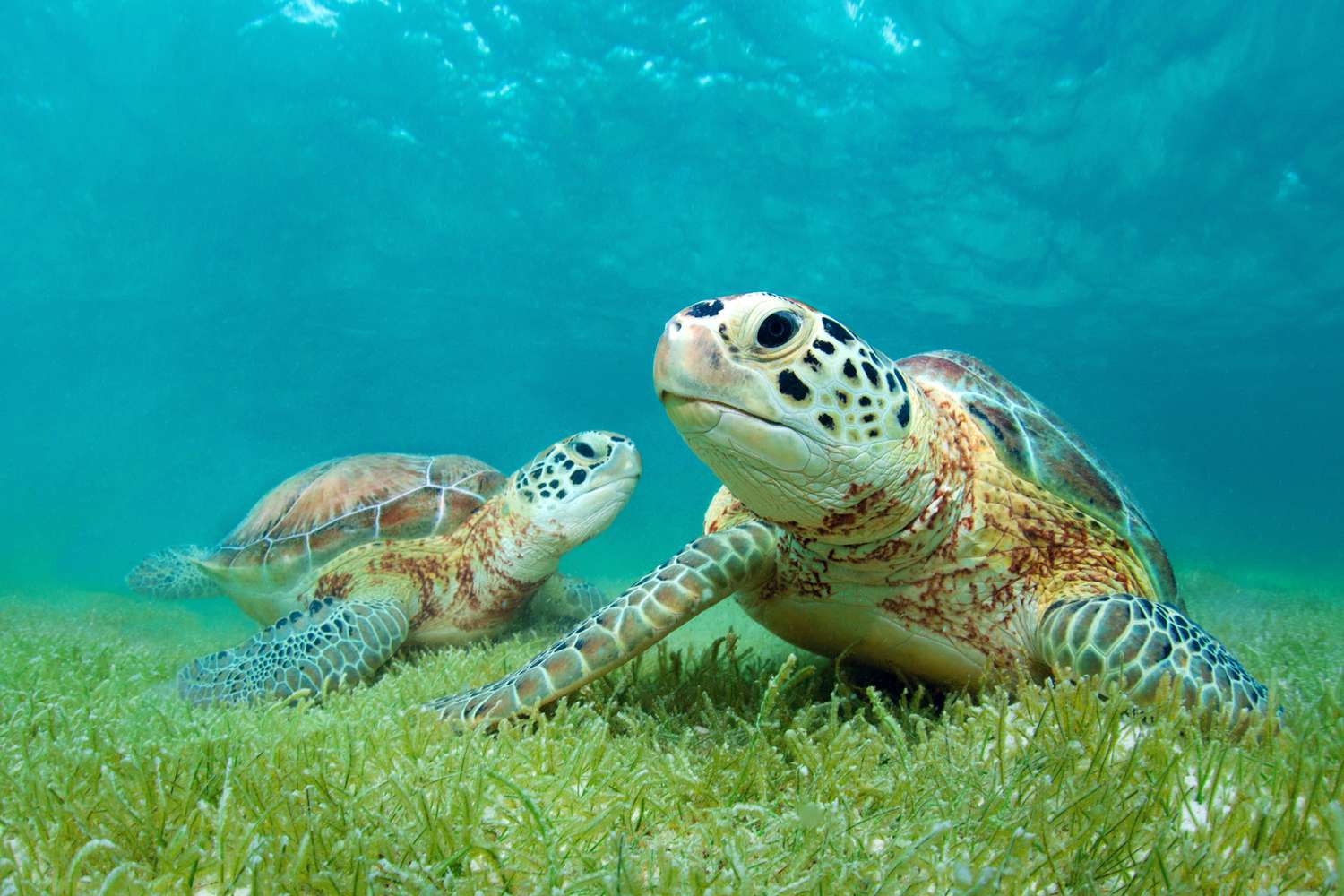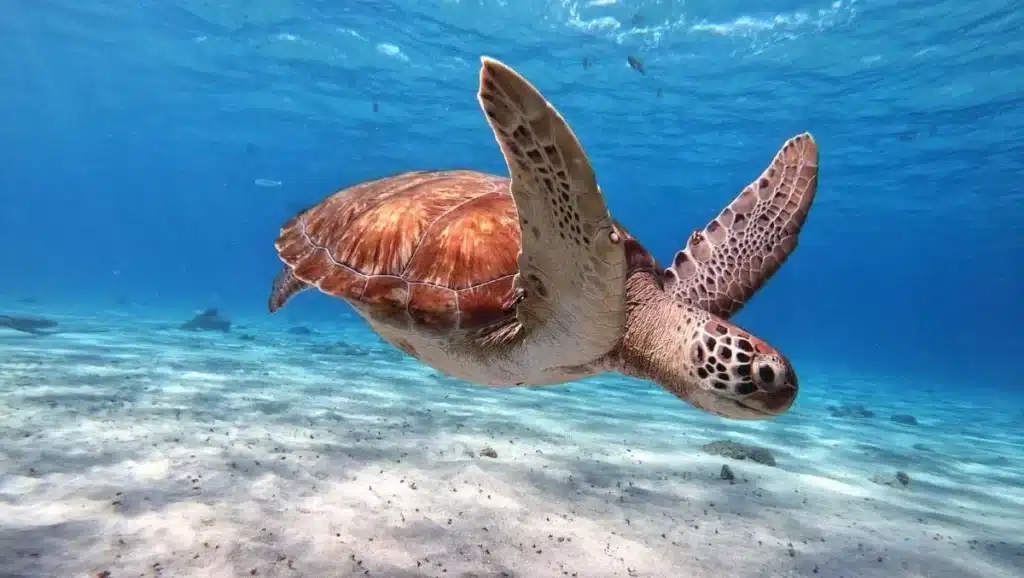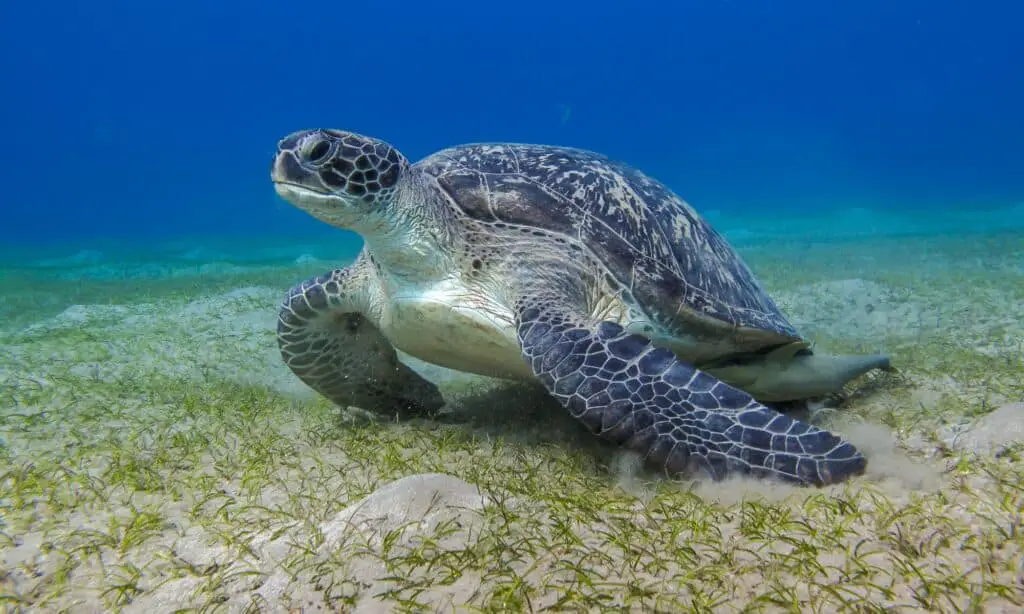Are Sea Turtles Herbivores

Introduction
Are Sea Turtles Herbivores: Sea turtles are fascinating creatures that have inhabited Earth’s oceans for millions of years. These ancient reptiles are renowned for their majestic appearance and their vital role in marine ecosystems. One intriguing aspect of their biology is their dietary preferences. While there are several species of sea turtles, some of them are primarily herbivorous, meaning they primarily consume plant-based foods, making them unique among marine reptiles.
Understanding the dietary habits of sea turtles is essential for comprehending their ecological significance and the interconnectedness of marine life. In the vast expanse of the world’s oceans, sea turtles play a crucial role in maintaining the health of underwater ecosystems. Their consumption of seagrasses and algae helps control the growth of these plant populations, preventing overgrowth that could harm marine habitats.
To fully appreciate the ecological significance of herbivorous sea turtles, it’s important to examine the diverse species within this group and how their diets vary. From the green sea turtle’s preference for seagrasses to the hawksbill turtle’s fondness for sponges, each species exhibits unique feeding behaviors that reflect their adaptations to specific environments and niches.
By unraveling the dietary habits of these ancient mariners, we gain insight into the delicate balance of life in the oceans and the importance of conserving sea turtle populations to preserve the health of marine ecosystems. This exploration will shed light on the intriguing world of herbivorous sea turtles and their vital role in the underwater realm.

Which species of sea turtle is herbivorous?
Adult green turtles are herbivores, which means they eat only plants such as seagrasses and algae. This diet is thought to give them their greenish-colored fat, hence the name, the green turtle.
The herbivorous sea turtle species, primarily known for their plant-based diet, is the green sea turtle (Chelonia mydas). These magnificent creatures are found in warm tropical and subtropical waters around the world. Their name, “green,” is derived from the color of their fat, rather than their outer shell, which can be brown, black, or olive.
Green sea turtles are true vegetarians, with their diet consisting mainly of seagrasses and algae. They play a crucial role in maintaining the health of marine ecosystems by keeping seagrass beds in check through their grazing, preventing overgrowth that can negatively impact other marine life. Their powerful jaws are adapted for tearing and crushing plant material, making them efficient herbivores.
Despite their herbivorous nature, green sea turtles face numerous threats, including habitat destruction, pollution, and accidental entanglement in fishing gear. Conservation efforts are crucial to protect these gentle herbivores, as they are not only an essential part of the marine ecosystem but also a symbol of the fragile balance that exists in our oceans.
Is A turtle a carnivore or herbivore?
Most turtles and tortoises are omnivores, eating plants and food of various kinds, like fish, snails, worms, and insects. Many are strictly herbivores and only eat grasses, leafy plants, flowers, fruits, and even cactus.
Turtles, intriguing creatures with diverse dietary habits, cannot be strictly categorized as either carnivores or herbivores. Their feeding preferences vary significantly depending on their species. For instance, green sea turtles (Chelonia mydas) are predominantly herbivores, favoring seagrasses and algae. Their sharp-edged beaks are specialized for cropping vegetation, and their digestive systems are adept at processing plant matter.
Conversely, loggerhead sea turtles (Caretta caretta) lean towards carnivory, relishing a diet consisting primarily of crabs, mollusks, and jellyfish. Leatherback sea turtles (Dermochelys coriacea) possess unique feeding adaptations, using specialized papillae in their mouths to catch slippery prey like jellyfish. Hawksbill turtles (Eretmochelys imbricata) exhibit an omnivorous tendency, consuming sponges, sea anemones, and occasional algae.
In terrestrial environments, some freshwater and terrestrial turtles also display a mixed diet. For instance, the omnivorous red-eared slider (Trachemys scripta elegans) consumes both aquatic plants and small invertebrates.
This wide-ranging dietary diversity underscores the adaptability of turtles across different habitats and ecosystems. It also highlights the pivotal role they play in maintaining ecological balance. Thus, while some turtles may be predominantly herbivores, others are decidedly carnivorous or even omnivorous, illustrating the nuanced nature of their feeding behaviors.
Do any turtles eat meat?
Most semiaquatic and aquatic turtles, like red sliders, painted turtles, and pond turtles, are omnivores, which means they eat a combination of animal protein and vegetables. Some species, such as the spiny soft-shell turtle, are considered carnivorous and eat primarily animal protein.
Indeed, several species of turtles are carnivores, meaning they primarily feed on meat. The most notable example is the loggerhead sea turtle (Caretta caretta), which has a predominantly carnivorous diet. These majestic creatures are known to consume a variety of marine organisms including crabs, mollusks, and jellyfish. Their powerful jaws and sharp beaks are well-adapted for capturing and consuming prey.
Another example is the snapping turtle (Chelydra serpentina), a freshwater species known for its aggressive feeding behavior. They are opportunistic carnivores, feasting on fish, amphibians, insects, and even small mammals that venture too close. The alligator snapping turtle (Macrochelys temminckii) is even more formidable in its carnivorous pursuits, often ambushing fish with its cavernous mouth.
In addition to these, various other species exhibit omnivorous tendencies, incorporating both plant and animal matter into their diets. For instance, hawksbill turtles (Eretmochelys imbricata) consume sponges, sea anemones, and occasionally algae, displaying a mixed dietary preference.
This diverse range of feeding habits among turtles highlights their adaptability to different environments and underscores their crucial role in maintaining ecological balance within their respective ecosystems. While some turtles are herbivores, others are undeniably carnivores or omnivores, showcasing the complexity and versatility of their dietary behaviors.
Are tortoises herbivores?
Most tortoises are herbivores, meaning they prefer fruits, vegetables and plants, though some tortoises eat live food, making them omnivores. Turtles will eat it all: fruits, vegetables and meat, making them omnivores.
They are renowned for their strict plant-based diet, which typically consists of a variety of grasses, leafy greens, fruits, and even certain types of cacti. Their specialized beaks are adapted for tearing and chewing vegetation. Tortoises have a digestive system designed to process fibrous plant material efficiently. Their slow metabolism and unique gut flora allow them to extract maximum nutrition from the plant matter they consume.
However, it’s worth noting that while tortoises are predominantly herbivores, their specific dietary preferences can vary depending on the species and the natural vegetation available in their habitat. Some tortoises may favor certain types of plants over others, and in captivity, their diet should be carefully curated to replicate their natural foraging habits.
Despite their herbivorous nature, tortoises are remarkable in their ability to thrive in a wide range of environments, from arid deserts to lush grasslands. This adaptability, coupled with their vital role in shaping and maintaining their ecosystems, makes them fascinating and ecologically significant creatures in the animal kingdom. Understanding their dietary habits is crucial for their well-being, especially for those kept in captivity.
Which turtle is mainly herbivorous?
Green turtles are the only herbivorous species of sea turtle. Their diet mainly consists of algae and seagrasses, though they may also forage on sponges, invertebrates, and discarded fish. The East Pacific green turtle tends to eat more animal prey than other populations.
The turtle species that is primarily herbivorous is the green sea turtle (Chelonia mydas). These remarkable marine creatures are renowned for their predominantly plant-based diet. Their preferred food sources include seagrasses, various types of algae, and occasionally other aquatic plants. Equipped with specialized jaws adapted for cropping and shredding vegetation, green sea turtles are well-suited for their herbivorous lifestyle. They play a crucial ecological role as herbivores, helping to control and maintain the health of seagrass beds and coral reefs in coastal areas.
Green sea turtles are found in warm oceans across the globe, often inhabiting shallow coastal waters. Due to their specialized feeding habits, they are particularly drawn to areas rich in seagrass meadows, which provide them with an abundant and essential food source.
While they are primarily herbivores, it’s worth noting that the diet of green sea turtles can vary slightly depending on factors like age and location. Younger turtles may consume more animal matter in their early years, while older individuals tend to rely predominantly on plants.
Understanding the herbivorous nature of green sea turtles is crucial for their conservation and protection, as it helps to ensure that their critical feeding habitats remain intact and undisturbed.
How do sea turtles consume their herbivorous diet?
Sea turtles have evolved remarkable adaptations to consume their herbivorous diet, primarily consisting of seagrasses, algae, and aquatic plants. Their feeding process is a testament to their remarkable adaptability to life in the ocean.
Green sea turtles, the quintessential herbivores among sea turtles, possess specialized jaws with finely serrated edges. These jaws are designed to efficiently crop and tear vegetation. Unlike terrestrial herbivores, sea turtles lack teeth, but their powerful beaks serve a similar function. Their esophagus is elongated and muscular, enabling them to swallow large amounts of plant material.
When feeding, green sea turtles approach seagrass beds or algae-covered rocks in coastal areas. They use their forelimbs to stabilize themselves while they nibble on the vegetation. Their large, paddle-shaped limbs provide balance and stability as they move through the water and forage.
In contrast, other species of sea turtles like loggerheads or hawksbills may have more generalized jaws adapted for a mixed or carnivorous diet. These turtles employ a range of feeding strategies, such as crushing shells or using specialized structures in their mouths to catch prey like jellyfish.
Overall, sea turtles’ feeding adaptations reflect their vital ecological role in marine ecosystems, maintaining the health and balance of coastal habitats. Understanding these mechanisms is crucial for their conservation and protection.
How important is the diet of sea turtles to their conservation?
The diet of sea turtles plays a pivotal role in their conservation efforts. These ancient creatures are integral to marine ecosystems, acting as both predators and prey, helping maintain a delicate ecological balance. Sea turtles primarily feed on seagrasses, jellyfish, crustaceans, and various species of algae. Maintaining a healthy diet ensures they have the energy and nutrients needed for critical life stages, such as reproduction and migration.
Unfortunately, human-induced factors like overfishing, habitat destruction, and pollution have led to a decline in sea turtle food sources. Depleted prey populations, particularly jellyfish, can lead to malnutrition and weakened immune systems, making them more susceptible to diseases and other threats. Moreover, ingesting marine debris mistaken for food further endangers their well-being.
Conservation efforts thus involve not only protecting nesting habitats but also safeguarding the food sources crucial to their survival. Implementing sustainable fishing practices, reducing plastic pollution, and preserving critical seagrass beds are imperative steps. By addressing the dietary needs of sea turtles, we’re not only aiding their individual well-being but also contributing to the broader health of the marine ecosystems they inhabit.
Do sea turtles need to drink water, or do they obtain all their hydration from their herbivorous diet?
Sea turtles have evolved a remarkable adaptation to their marine environment. Unlike terrestrial reptiles, they do not possess specialized glands for excreting excess salts. Instead, sea turtles primarily obtain their hydration from their herbivorous diet, which includes marine plants like seagrasses and algae.
While they do absorb some water through their skin and cloaca (the opening used for reproduction and waste elimination), it’s not a primary source of hydration. This adaptation allows them to thrive in the salt-laden waters of the oceans. It’s an essential aspect of their physiological makeup, enabling them to endure extended periods at sea without the need to return to shore for fresh water.
This reliance on their diet for hydration does leave them vulnerable to the effects of habitat degradation and overfishing. Disruption of seagrass beds and depletion of their food sources can lead to dehydration and malnutrition, exacerbating the challenges these creatures face. Therefore, protecting their habitats and ensuring the availability of their preferred food sources is crucial for the continued well-being and survival of sea turtles.

Conclusion
Sea turtles are indeed fascinating herbivores that play a pivotal role in maintaining the health and balance of marine ecosystems. This exploration of their dietary habits has revealed the remarkable adaptability of these ancient creatures, as they have evolved to thrive in diverse oceanic environments.
The diverse feeding preferences among sea turtle species highlight their ecological significance. Green sea turtles, with their affinity for seagrasses, help prevent the overgrowth of these underwater plants, preserving the habitats for countless marine species. Hawksbill turtles, on the other hand, demonstrate a unique niche by feeding on sponges, controlling populations of these organisms and influencing the composition of coral reefs.
Beyond their direct impact on plant populations, herbivorous sea turtles contribute to nutrient cycling in the oceans. Their digestive processes result in the release of essential nutrients back into the marine environment, benefiting the entire food web.
However, these magnificent creatures face numerous threats, including habitat destruction, pollution, and entanglement in fishing gear. Conservation efforts are imperative to ensure the survival of sea turtles and, by extension, the well-being of our oceans.
Sea turtles stand as emblematic symbols of the intricate web of life in the world’s oceans. Their herbivorous habits represent a vital thread in this web, emphasizing the need for continued research and conservation to protect these remarkable creatures and the ecosystems they help sustain. Preserving sea turtles is not just about safeguarding a species; it’s about preserving the delicate balance of life beneath the waves.



